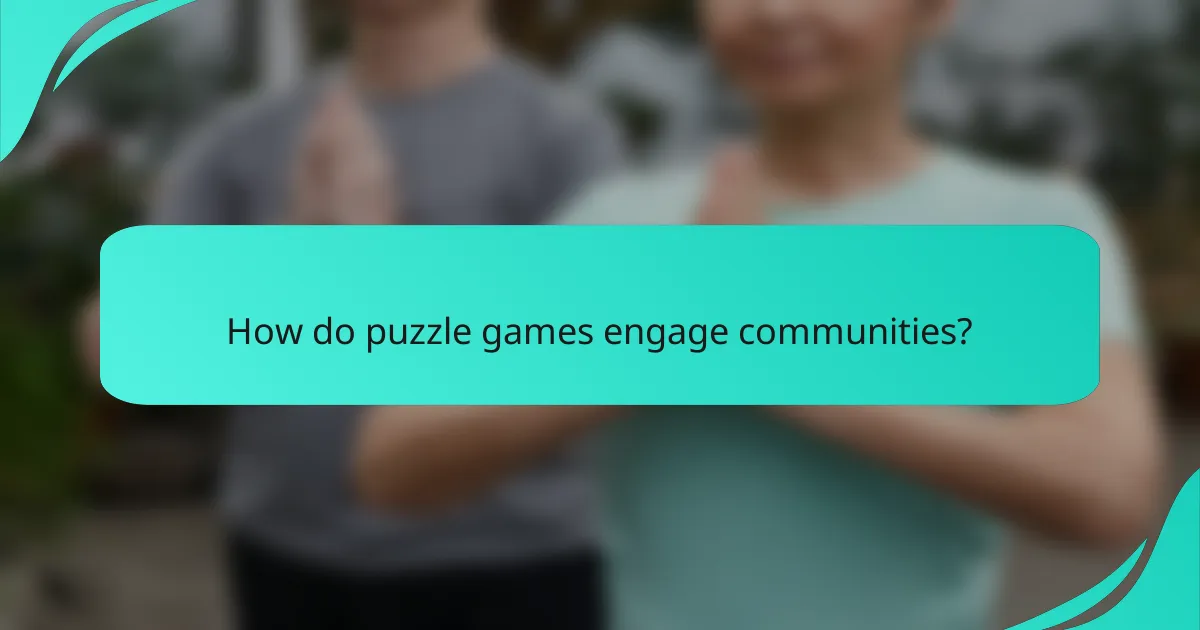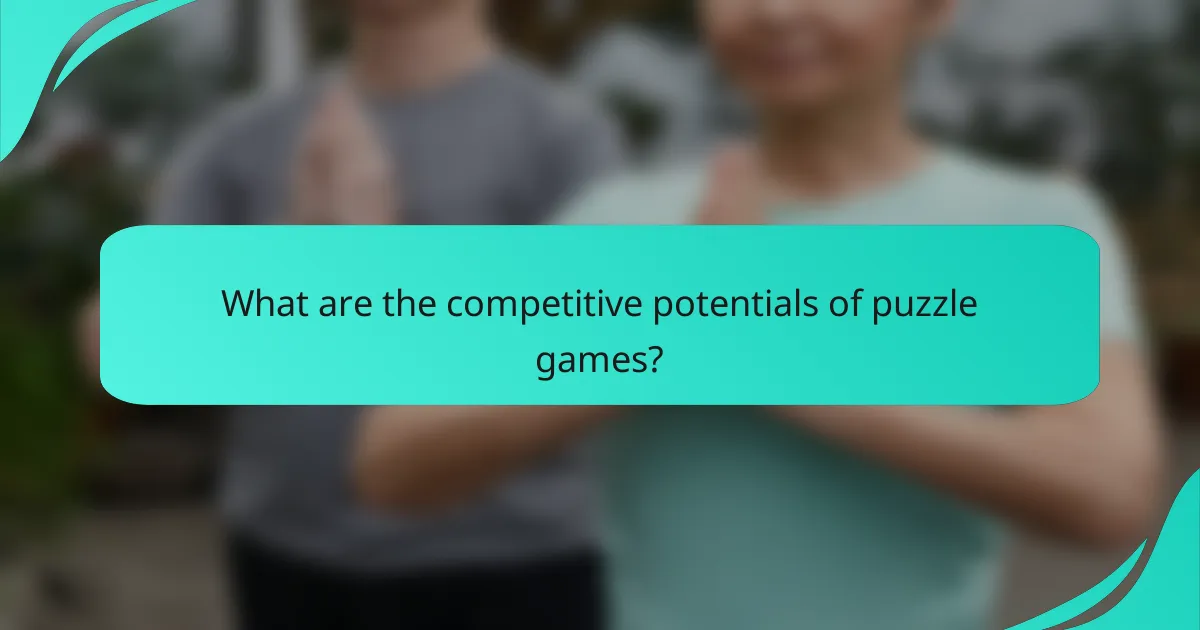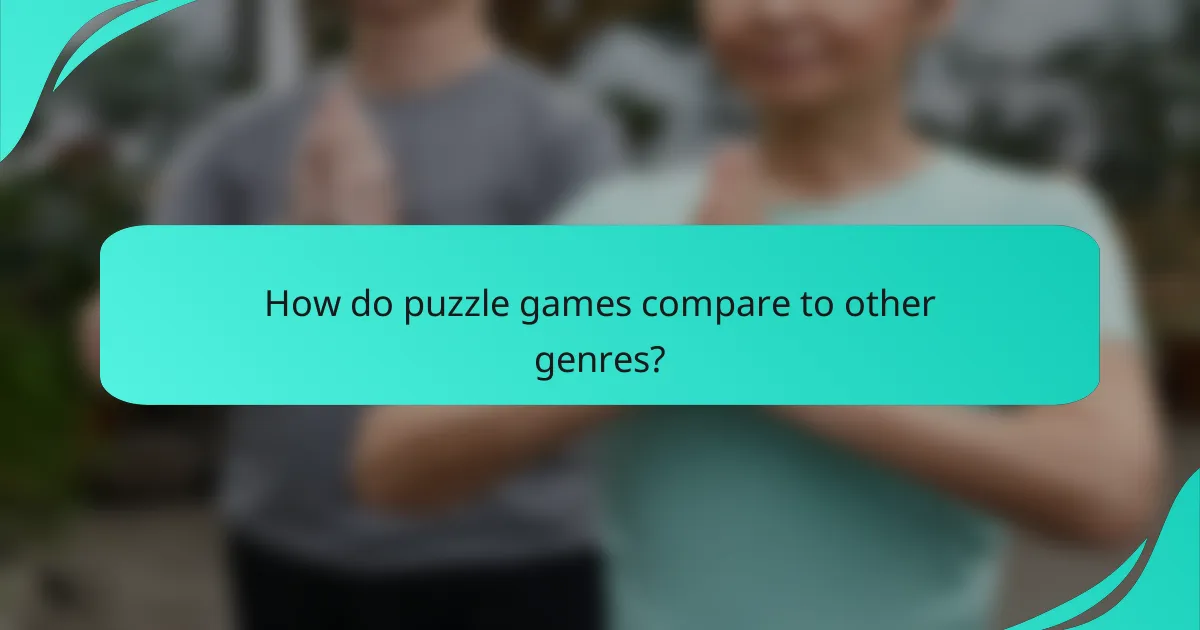The future of puzzle games is being transformed by technological advancements and changing player preferences, with trends such as augmented reality and artificial intelligence leading the way. These games not only engage players through competitive mechanics but also foster community interaction, enhancing the overall gaming experience. As puzzle games continue to evolve, they present significant opportunities for tournaments and social engagement, making them a vibrant part of the gaming landscape.

What are the future trends in puzzle games?
The future of puzzle games is shaped by technological advancements and evolving player preferences. Key trends include augmented reality, artificial intelligence integration, cross-platform play, social gaming features, and user-generated content.
Increased use of augmented reality
Augmented reality (AR) is set to enhance puzzle gaming by blending digital elements with the real world. This technology allows players to interact with puzzles in immersive environments, creating a more engaging experience. Games like Pokémon GO have paved the way, demonstrating how AR can attract and retain players.
Developers should consider the accessibility of AR features, ensuring that they are compatible with a wide range of devices. This can help broaden the audience and increase participation in AR-based puzzle games.
Integration of artificial intelligence
Artificial intelligence (AI) is transforming puzzle games by personalizing experiences and improving gameplay. AI can analyze player behavior to adjust difficulty levels, making challenges more suitable for individual skill sets. This adaptability keeps players engaged and encourages longer play sessions.
Moreover, AI can facilitate dynamic storytelling within puzzle games, enhancing the narrative and making the gameplay more compelling. Developers should explore AI tools to create more responsive and intelligent game environments.
Focus on cross-platform play
Cross-platform play is becoming increasingly important in puzzle gaming, allowing players to connect regardless of their device. This trend fosters larger communities and enhances competition, as players can challenge friends on different platforms. Games that support cross-play often see higher user retention rates.
To implement cross-platform functionality, developers must ensure that game mechanics and user interfaces are consistent across devices. This can involve additional testing and optimization to provide a seamless experience for all players.
Rise of social puzzle gaming
Social puzzle gaming is gaining traction as players seek collaborative and competitive experiences. Features like multiplayer modes, leaderboards, and social sharing options encourage interaction among players. This trend is particularly appealing to younger audiences who value community engagement.
Developers should incorporate social features that allow players to form teams or compete against each other. Creating events or challenges can further enhance community involvement and keep players returning to the game.
Emphasis on user-generated content
User-generated content (UGC) is becoming a significant aspect of puzzle games, as it allows players to create and share their own puzzles. This not only extends the game’s lifespan but also fosters a sense of ownership and creativity among players. Games that support UGC often benefit from a vibrant community that continuously contributes new content.
To successfully implement UGC, developers should provide intuitive tools for players to design and share their puzzles. Clear guidelines and moderation can help maintain quality and ensure a positive experience for all users.

How do puzzle games engage communities?
Puzzle games engage communities by fostering interaction among players through various platforms and activities. These interactions create a sense of belonging and competition, enhancing the overall gaming experience.
Online forums and discussion groups
Online forums and discussion groups are vital for puzzle game communities, providing spaces for players to share strategies, tips, and experiences. Platforms like Reddit or dedicated game forums allow users to discuss game mechanics, share solutions, and post challenges.
Active participation in these forums can lead to stronger community ties and a deeper understanding of the game. Players often form friendships and collaborate on solving complex puzzles, enhancing their engagement.
In-game events and competitions
In-game events and competitions are effective ways to engage players and foster community spirit. These events often include timed challenges or leaderboard competitions that encourage players to participate actively.
For example, seasonal events may offer exclusive rewards or limited-time puzzles, motivating players to log in regularly. Competitions can also lead to friendly rivalries, further enhancing community interaction.
Social media integration
Social media integration allows puzzle games to reach a broader audience and keep players connected. Game developers often use platforms like Facebook, Twitter, and Instagram to share updates, promote events, and showcase player achievements.
Players can share their progress and invite friends to join, creating a viral effect that draws more participants into the community. This integration also helps maintain ongoing conversations about game strategies and updates.
Collaborative puzzle-solving features
Collaborative puzzle-solving features enable players to work together to tackle challenges, enhancing community engagement. Many games now include options for players to team up, share hints, or even solve puzzles in real-time.
These features not only make the gameplay more enjoyable but also strengthen bonds among players. For instance, cooperative modes or shared puzzles can lead to discussions and strategies that benefit the entire community.

What are the competitive potentials of puzzle games?
Puzzle games have significant competitive potential, attracting players and audiences through engaging mechanics and strategic depth. They can foster a vibrant community, enhance player skills, and create opportunities for tournaments and events.
Growing esports scene
The esports scene for puzzle games is expanding, with more tournaments being organized globally. These events often feature both amateur and professional players, showcasing their skills in various puzzle genres, from classic match-three games to complex logic challenges.
As the audience for puzzle esports grows, developers are increasingly investing in competitive features, such as leaderboards and ranking systems, to enhance player engagement. This trend is likely to continue, making puzzle games a staple in the esports landscape.
Monetization through sponsorships
Puzzle games can generate revenue through sponsorships, as brands seek to connect with the gaming community. Sponsorships can come from various sectors, including tech, education, and lifestyle brands, which see value in reaching puzzle enthusiasts.
To attract sponsors, developers should focus on building a strong player base and engaging community events. This can include hosting tournaments with live streams, where sponsors can gain visibility and interact with potential customers.
Partnerships with educational institutions
Partnerships with educational institutions can enhance the competitive landscape of puzzle games by promoting cognitive skills and problem-solving abilities. Schools and universities may incorporate puzzle games into their curricula, recognizing their potential for learning and development.
These collaborations can lead to organized competitions, where students can showcase their skills in a fun and engaging environment. Additionally, educational partnerships can provide funding and resources, further supporting the growth of competitive puzzle gaming.

What criteria should developers consider for puzzle games?
Developers of puzzle games should prioritize user experience, monetization strategies, and market research to create engaging and profitable products. Each of these criteria plays a crucial role in attracting and retaining players while ensuring financial sustainability.
User experience and accessibility
Creating a positive user experience is essential for puzzle games, as it directly affects player retention and satisfaction. Developers should focus on intuitive controls, visually appealing designs, and engaging gameplay mechanics that cater to various skill levels.
Accessibility is equally important; incorporating features like adjustable difficulty levels, color-blind modes, and voice commands can help reach a broader audience. Ensuring that the game is playable on multiple devices can also enhance accessibility.
Monetization strategies
Effective monetization strategies are vital for the financial success of puzzle games. Common approaches include in-app purchases, ad-based revenue, and premium pricing models. Developers should consider a mix of these strategies to maximize earnings while maintaining a positive user experience.
Offering free trials or limited-time promotions can attract new players. However, it’s crucial to avoid aggressive monetization tactics that could alienate users, such as excessive ads or paywalls that hinder gameplay.
Market research and audience targeting
Conducting thorough market research helps developers understand current trends and player preferences in the puzzle game genre. Analyzing competitors and identifying gaps in the market can inform the development process and enhance the game’s appeal.
Targeting specific audience segments, such as casual gamers or puzzle enthusiasts, allows for tailored marketing strategies. Utilizing social media and gaming forums can help developers engage with potential players and gather valuable feedback during the development phase.

How do puzzle games compare to other genres?
Puzzle games often emphasize problem-solving and cognitive challenges, setting them apart from action or adventure genres that focus on speed and exploration. While puzzle games may attract a diverse audience, they typically engage players through strategic thinking and creativity, making them unique in the gaming landscape.
Player engagement metrics
Player engagement metrics for puzzle games can include session length, daily active users, and retention rates. These metrics help developers understand how effectively their games captivate players compared to other genres. For instance, puzzle games may see average session lengths ranging from 10 to 30 minutes, which can be longer than fast-paced genres.
Monitoring player engagement involves analyzing in-game behaviors such as completion rates and levels attempted. High completion rates often indicate that players find the puzzles satisfying, while low rates may suggest that the difficulty is either too high or too low. Developers should aim for a balance that keeps players challenged but not frustrated.
To boost engagement, consider implementing features like daily challenges or leaderboards. These can encourage players to return regularly and compete with friends, enhancing the community aspect of puzzle games. Avoid making puzzles overly complex without adequate hints, as this can lead to player drop-off.
